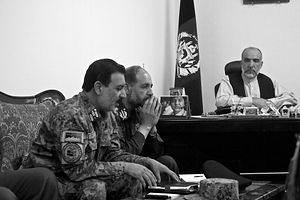Yesterday, the commander of U.S. Forces in Afghanistan, Gen. John F. Campbell, testified in front of the U.S. House of Representatives Armed Services Committee on the current situation in Afghanistan. Gen. Campbell first and foremost called for “strategic patience” when dealing with Afghan government forces engaged in fighting in the Taliban insurgency.
U.S. forces officially ended their combat mission (Operation Enduring Freedom) in the country in January 2015. Now, troops from 41 nations are assisting and advising Afghan National Security Forces under a new, much reduced, NATO mission called Resolute Support. Also, U.S. special forces continue to carry out a counter-terrorism mission and hunt the remnants of Al Qaeda and other terror groups in Afghanistan.
“Our Afghan partners have proven that they can and will take the tactical fight from here. They are ready, and it is time,” Campbell notes optimistically. Yet he also cautions that “in spite of considerable progress, it is clear that our campaign will remain a challenging one.” He points out that delays in signing the Bilateral Security Agreement (BSA) and the NATO Status of Forces Agreement (SOFA), as well as setbacks in forming a new cabinet, “have created a period of comparative stagnation in ANDSF [Afghan National Defense & Security Forces] institutional development.”
Campbell emphasizes that the next two years will be crucial in determining whether Afghan forces can hold on to and solidify their gains over the insurgents. “In their second fighting season in the lead, the ANDSF proved proficient at securing the Afghan people, fighting their own battles, and holding the gains achieved by ISAF over the last 13+ years,” he states. Campbell also reported that for the first time since Afghan forces assumed the lead in combat operations, they launched a large-scale cross-pillar and multi-corps operation (Operation ZOLFIQAR) to clear out insurgents from historical areas of insurgent activity, including the Sangin and the Upper Sangin Valley in Helmand province.
However, Afghan forces will not be able to bear increasing casualty rates for too long, Campbell said. “A high ANDSF attrition rate, which accounts for casualties and all other losses to the force, has had an impact on combat readiness. If present rates continue, it will pose challenges to force development over time. The main causes of ANDSF attrition are assessed as poor leadership; high operational tempo; inadequate soldier/police care; and poor force management.”
Several well-known weaknesses still persist in the Afghan force structure. “Their most critical gaps are found in aviation, intelligence, special operations, and the ASI’s ability to conduct tasks such as planning, programming, budgeting, and human resource management,” Campbell said.
U.S. forces are also trying to deal with peculiar cultural differences: “We are also working with the Afghans to break the culture of hoarding and eliminate false claims of shortages in order to garner more resources and assistance.”
Campbell also notes that that the Taliban will not be able to defeat the ANDSF on the battlefield in 2015. However, he testifies that “the Taliban will most likely be willing to absorb considerable casualties and physical losses in order to gain psychological victories.”
He also notes that both Afghanistan and Pakistan are now jointly pushing for reconciliation with the Taliban – a first in 14 years of war.

































